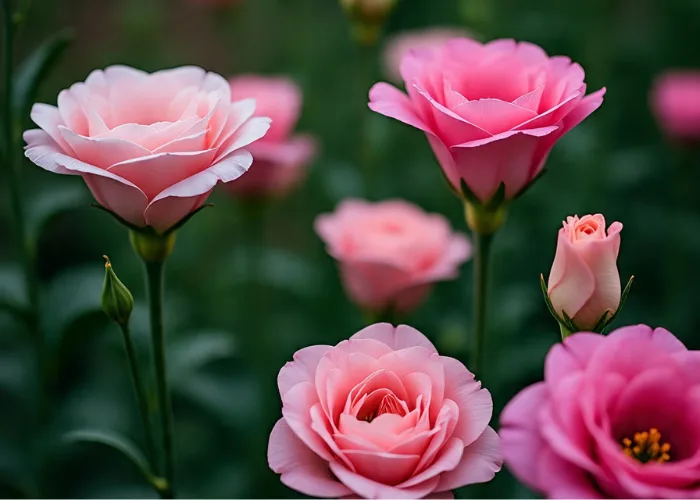How to Grow Lisianthus (Prairie Gentian): The Complete Guide

If you’re in search of flowers that combine beauty as well as elegance and strength you need to take a look at the Lisianthus (Eustoma grandiflorum) Also called Prairie Gentian. Lisianthus is a popular flower that graces floral and garden bouquets with it’s delicate but beautiful flowers. Its rose-like appearance with long-lasting flowers and vivid shades, Lisianthus has captured the hearts of floral designers and gardeners at home alike.
Growing Lisianthus is an enjoyable experience, however for you to appreciate the beauty of Lisianthus it is essential to know its requirements for growth, the most effective methods for planting, and how to take care of the plant over its entire life period. In this comprehensive guide, we’ll go over everything from planting Lisianthus beginning with seeds, to maintenance tips, and the most suitable companion plants. Let’s take a look at the most comprehensive guide to growing and maintain Lisianthus.
About Lisianthus
Lisianthus is one of the flowering plants that belong to the Gentianaceae family. Originarily indigenous the continent of North America, particularly the southern United States, Lisianthus thrives in a range of habitats including prairies, wetlands and fields. This plant has earned it the name Prairie Gentian because of its durability in harsh growing conditions. Its botanical designation, Eustoma grandiflorum, is nowadays less frequent and Eustoma russellianum becoming the preferred name in many gardening books.
Lisianthus blossoms come in all kinds colors, such as pink, purple white, yellow and. They grow on sturdy stems that reach an average height of 1-3 feet. They are herbaceous and have a perennial pattern of growth. The blooming season lasts from summer’s beginning to the end of autumn, contingent on the kind of plant and the climate. Lisianthus is one of the most popular cut flowers because it is a long-lasting flower that last at least two weeks the vase.
When to Plant Lisianthus
Timing is crucial when it comes to the growth of Lisianthus. Because it is a warm-season flower, it needs some amount of temperature control in order for it to flourish. Lisianthus should be planted following the last frost of the area you live in, which typically is in the late spring. If you live in an area with a milder climate (zones 8-10) it is possible to plant Lisianthus straight into the soil. However, if you’re in a colder climate it is recommended to plant the seeds in the indoors first, later transplant them outdoors when the temperature reaches 60degF.
The depth of the planting is crucial too; it is recommended to plant seeds 1/4 inch from the surface in well-drained, moist soil. To get the best results, plant Lisianthus in raised beds or containers when you’re worried about soil quality as they’re a little susceptible to soil conditions that are poor.
How to Start Lisianthus From Seed
Growing Lisianthus seeds from seed can be a bit difficult for those who are new to gardening. Because Lisianthus seeds are small and fragile, they require extra attention throughout the germination process. It is suggested to plant indoors as seeds take a long time to germinate and the temperature needs to be maintained.
- Step 1: Utilize an unused seed tray or plastic containers that are filled with premium seed-starting mix. It should have a moist soil but not too wet. Avoid excessive watering as it can lead to root decay.
- Step 2: Store the container in a cool place (around 70 to 75 degrees Fahrenheit) to promote germinating. Some gardeners suggest making use of a heating mat to ensure a constant temperature.
- Step 3: Once seeds start to sprout, let them develop for 8-12 weeks inside before transferring them outside.
Transplanting is recommended after all frost risk is gone. If you’re strapped to time, you could purchase plugs at the local nursery. These plants that are small and pre-grown are usually established and will bloom faster than those that were which were started from seeds.
Types of Lisianthus
Lisianthus is available in a broad variety of cultivars that each have their particular color palette and bloom shape. Certain varieties are more suitable to certain climates, while others are more decorative. Below are some varieties of Lisianthus worth considering:
“Balboa” White Lisianthus

A pure white variety with a sophisticated sleek appearance, ideal for bouquets for weddings.
“Forever Blue” Lisianthus

The Lisianthus is famous for its bright blue blooms, this species offers a striking contrast any arrangement in the garden or flower arrangements.
Flamenco

A strong and vibrant variety with frilled edges, ruffled petals and ruffled edges with shades of red, white, and pink.
Sapphire Pink Rim

This kind of Lisianthus is characterized by soft pink petals that are bordered by an edgier pink rim giving a striking look.
Echo Blue

A breathtaking blue Lisianthus variety that is perfect for bouquets with lots of color and lush gardens.
Lisa Pink

Lisianthus Soft pink blooms ideal for romantic bouquets and gardens.
Lisianthus flowers can be found in double and single blooms so you can pick the one that fits your style of gardening.
Where to Plant Lisianthus
When planting Lisianthus it is essential to select the best location. They thrive in full sun Therefore, ensure that you plant them in an area that will receive at minimum 6-8 hours of direct sun each day. Raised beds or soil that is well-drained for gardening are ideal for the planting of Lisianthus since they like well-drained and moist soils. The soils that are heavy or clayey and contain too much moisture can cause root rot, which is why it’s important modify the soil prior planting by adding organic matter or compost.
If you’re planting the Lisianthus in containers, make sure you use a large pot with drainage holes in order to make sure that the soil doesn’t hold excessive water. Container gardening can also give you greater control over the surroundings, making it easier to control the humidity and temperature.
Lisianthus Care Tips
Care for Lisianthus plants is quite simple, however it needs a few particular factors to consider. Here are some important Lisianthus-specific suggestions to help you cultivate healthy plants:
Light
Lisianthus requires sun-filled days to bloom in vibrant colors. If you’re cultivating Lisianthus indoors, you can place them in a window facing south or utilize grow lights to complement the natural lighting. Artificial light can aid in the development of the growth of stronger, smaller plants.
Soil and Watering
Lisianthus likes moist, well-drained soil, but it’s important to be careful not to overwater. It is vital to water regularly but it is important to let the soil dry out a bit between the waterings. Soak the soil in a deep, but allow the top layer dry prior to adding more water.
It is also important for you to enrich the soil using compost in order to improve soil drainage as well as its organic material. Mulching the soil around the base of the plant is a great way to hold water and help keep the root cool during summer.
Temperature and Humidity
Lisianthus thrives in hot temperatures, however it’s not a great choice for excessive heat or humidity. Maintain the temperature between 60 and 75 degrees F and ensure adequate air circulation throughout the plant to avoid problems that can result from fungal growth. The proper flow of air is vital particularly if you’re growing Lisianthus in greenhouses, or in tunnels.
Fertilization
To ensure the health of your plants to ensure healthy growth, feed your Lisianthus plant every 2 to 4 weeks with an appropriate fertilizer. You can choose a slow-release fertilizer which can be used with flowers. Be aware that fertilizing too much can result in weak stems and a poor flowering.
Pruning and Deadheading
Pruning is crucial to promote the highest growth and flowering. Deadhead spent flowers often to encourage the development of buds. Some gardeners recommend cutting off the tops of plants to increase branching and the number of blooms. The trimming of the buds is also an a solution for people who wish to increase their flower count.
How to Propagate Lisianthus
It is possible to propagate Lisianthus using seeds However, it can also be propagated by cuttings. To reproduce through cuttings, choose healthy stems during the spring, and cut into sections of 3-4 inches. Take the leaves off from the base of the cutting to soak it in rooting hormone, then put it down in a well-drained, moist medium.
It is also possible to propagate Lisianthus by division when you’re cultivating perennial varieties. Simply dig the plant, break the roots, then plant the divisions in a well-prepared soil.
Common Problems and Solutions
While Lisianthus is an easy-care flower however, it may still encounter problems with diseases and pests. A common problem is mildew that’s powdery, and can be controlled with regular inspection and maintaining a good air circulation. Infections caused by fungal fungi can be combated by ensuring proper drainage of the soil and air flow. It is also possible to combat employing fungicides if needed.
Pests like aphids as well as spider mites are also a threat to Lisianthus however they can be fought off by regularly checking the plants and employing organic methods for pest control.
Lisianthus Companion Plants
Lisianthus is a great match for other blooms of summer and can add to the overall design the garden. You might want to plant zinnias, ornamental peppers, or an annual vinca in conjunction with your Lisianthus, to create a mix of size as well as texture and the color.
Conclusion
Growing Lisianthus is an enjoyable experience, whether you’re adding them into your landscape or using them to cut flowers. If you give them the proper care and focus, Lisianthus can thrive and flower beautifully for the years to come. If you follow the advice in this article and you’ll be on the way to cultivating a the most beautiful colorful arrangement of blooms. You can plant them to enjoy their beautiful blooms, to beautify your yard, or cut to make arrangements Lisianthus will add joy to the gardening process.
